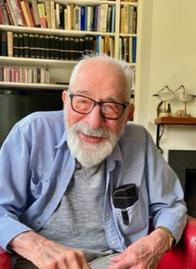 |
|
| Marc Jaffe | |
Marc Jaffe, a longtime book publisher who "oversaw a boom in paperback publishing that began in the 1960s, putting out hitmakers from The Catcher in the Rye to Jaws," died December 31, the New York Times reported. He was 102.
Among Jaffe's many successes was coaxing J.D. Salinger into publishing The Catcher in the Rye with Bantam in the early 1960s "by promising to produce the book with no illustration on its cover (Salinger would have preferred that it be produced in mimeograph form, as Mr. Jaffe told Kenneth C. Davis, author of the 1984 book Two-Bit Culture: The Paperbacking of America)," the Times wrote. "The novel had first appeared in 1951 in hardcover, under Little, Brown, and then as a Signet paperback, whose illustration the author loathed."
"Marc was the epitome of a great editor," said Alberto Vitale, former chairman of Random House, who worked with Jaffe at Bantam for a time. "He had a great nose for fiction and for nonfiction, and he had a great nose for what sells."
Recalling the success of Peter Benchley's Jaws in paperback, Vitale noted that Jaffe worked hard to promote the book around the world, though there was a bit of pushback from Bantam's subsidiaries in England and Australia. "The Brits said, 'But we don't have sharks.' The Australians said, 'We have plenty of sharks, but we don't like them.' " Nonetheless, Jaffe prevailed, Vitale said, and "the damn book sold another million and a half copies in the Commonwealth."
The author whose work was closest to Jaffe's heart, and who sold more books for him than any other writer, was Louis L'Amour, with whom he published more than 100 titles.
In 1948, Jaffe was in New York City, working first for the men's magazine Argosy and then for New American Library, editing writers like Mickey Spillane and Gore Vidal. By 1961, he was editorial director at Bantam Books, where he stayed for nearly two decades at the forefront of the mass paperback revolution, beginning after World War II and lasting through the 1980s.
Jaffe and Bantam president Oscar Dystel were responsible for publishing an extraordinary list, which brought them to the top of the paperback industry. During those years Jaffe was personally responsible for a number of important commercial bestsellers, led by William Peter Blatty's The Exorcist. At the other end of the spectrum were many titles in the Bantam Modern Classics series, and the unique text and design work by Marshall McLuhan and Quentin Fiore, The Medium Is the Massage. When asked what he considered his most important publishing contribution, Jaffe would offer his initiation and continuing support for Bantam's series of foreign-language dictionaries.
He worked next at Ballantine Books and then founded Villard Books, for Random House, in 1983. By 1986, he had launched another imprint, under his name, for Houghton Mifflin, where he published an eclectic mix of titles. Jaffe left Houghton Mifflin more than two decades ago to work as a freelance editor with his second wife, Vivienne (Sernaqué) Jaffe, who survives him. He was still working at his death.

